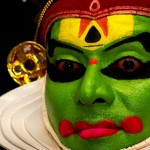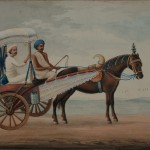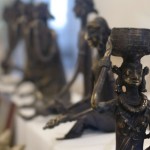When we try to look into the ancient cultures of different countries and their means of entertainment, drama is something which is common to most of these cultures. Be it the English, the Greeks, or the Indians, one of their major forms of entertainment was narrating stories and acting them. Kathakali is one such form which is native to the state of Kerala.
Kathakali is a form of dance drama, originated approximately 1500 years ago in Kerala. The word ‘katha’, in Sanskrit means ‘story’ and ‘kali’, in Malayalam means ‘play’. In olden times, the dance performance included prayer and was used to tell stories of Gods or traditional folk tales. It was performed for religious purposes in temples or as entertainment in the courts of the kings.
The stories narrated are that of ancient kings, brave men, or from Hindu mythology, mainly Mahabharata, Ramayana or stories of Lord Shiva. They are enacted in the form of dance, based on the facial expressions, body movements, hand movements (mudra), of the performer. There is no speaking by the actors/dancers, the music or the narration from back-stage tells us the story. The language of the songs or the narration is either Malayalam or Sanskrit. The performers dress up in elaborate costumes with painted faces or heavy make-up. The different characters are recognized by their costumes. The costumes are called, ‘Minukku’, ‘Thatti’, ‘Sathwika’, and ‘Kathi’. As the performances take place at night, they are carried out in front of Kalivilakku, meaning dance lamps, in order to enhance the beauty of the visual.
Traditionally there are 101 stories that are performed in Kathakali. Out of these only a few have a place in regular performances. Duryodhana Vadham, Keechakavadham, Karnashapatham, Harishchandracharitam, etc, are some of the stories that get staged. In olden times, the time span of one performance used to be the whole night. It would begin at night and last till dawn. Lately, the performances have been made more concise so as to save time. They last for three to four hours. Due to cutting short of the time span, some of the stories which are too long have to be performed by only taking the major parts and not as a whole.
Sanskrit poet Bharat Muni’s Natyashatra, has been a major source of inspiration for the creators of this form of art. Other ancient forms of traditional drama like, Kootha, Koodiyattam, and Krishnanattam have also inspired Kathakali. This classical dance also uses the elements of Kalaripayattu, a form of martial arts, belonging to Kerala. The performers of Kathakali are well trained in this martial art. Around the 17th century, improvements were made in Kathakali by Vettathu Raja. There were several changes made by the king of Kottarakara, by introducing Malayalam in the songs, along with Sanskrit. The Kathakali which is performed today has been given by Vallathol Narayana Menon, who founded the Kerala Kala Mandalam. He helped in popularizing the art worldwide.
In order to give visibility to the art, giving it an exposure, to develop it further, stories from other literature have been taken as Kathakali performances. Shakespeare’s King Lear and Julius Caesar and Goethe’s Faust are some such works which have seen the light of ancient Indian culture.
Kathakali is a fine blend of culture and tradition with art and creativity. It is one of those forms of art which has been sent down through generations and is preserved. It represents Kerala, God’s own country.







